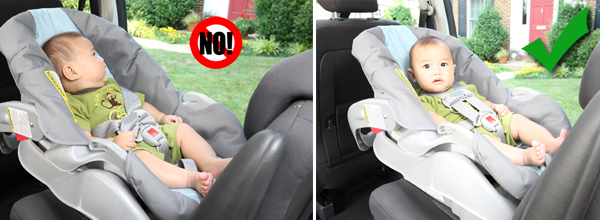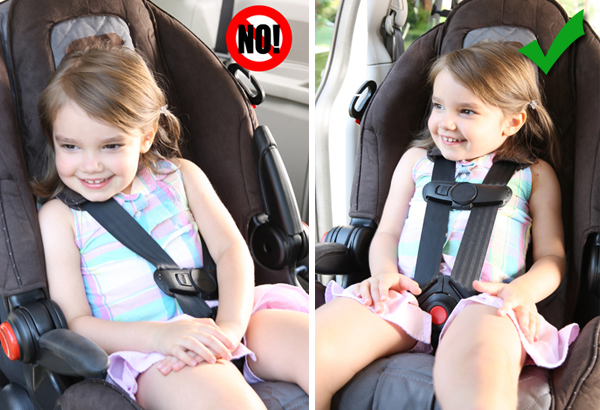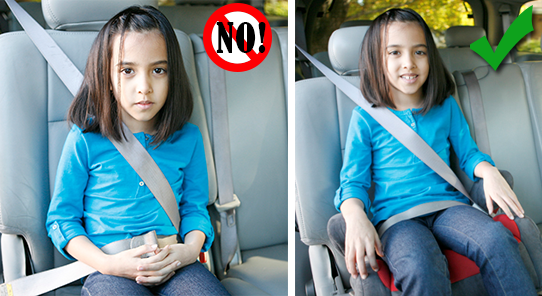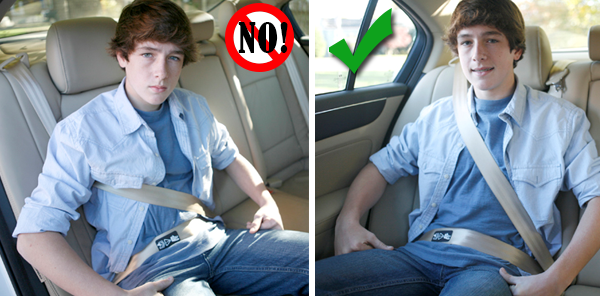Motor vehicle crashes remain a leading cause of death for children. Since 2002, AAA clubs across the country have worked to enact stronger child restraint laws in every state and the District of Columbia. AAA continues to be active at the national, state and local levels in promoting child passenger safety through education and public policy.
Additional Resources
If you’re a member of the media, please visit NewsRoom.AAA.com for full contact information.
For a car seat inspection near you, visit seatcheck.org.
To find a AAA office near you, visit AAA.com.

- Rear-facing seats should be installed in the back seat of your vehicle. Never place a rear-facing seat in front of an active passenger frontal air bag.
- The center seating position is ideal if it can be used, since it is the farthest from any point of impact.
- The seat should be installed using either the LATCH system or vehicle safety belt, never both.
- If using the LATCH system, buckle all unused safety belts to prevent the possibility of strangulation.
- If using a safety belt, make sure the belt is locked and can hold the seat tightly. You should not be able to move the seat more than one inch in any direction when testing where the belt goes through.
- Rear-facing safety seats should be installed in the recline mode to protect your baby’s breathing. Be sure to refer to the safety seat manufacturer’s degree recommendation.
- Harnesses should be at or below your child’s shoulders. The harnesses should be snug and lie flat on your infant’s shoulders, and you should not be able to pinch any slack.
- The chest clip should be positioned at armpit level, across your infant’s sternum. This protects soft tissue and helps keep the harness straps on your baby.
- To prevent injury, secure any unused tethers when installing the safety seat.
Children can ride forward-facing in a vehicle’s back seat once they have reached the upper weight (30 to 35 pounds) or height limit of their rear-facing convertible seat, which will typically be around age 2. It is safest to keep your child in a forward-facing seat with a harness until he or she reaches the seat’s maximum height or weight (40 to 65 pounds) limits.
Forward-facing seats include an internal harness system that keeps a child properly restrained and snug straps that limit forward motion. In the event of a crash, the forward-facing position provides for even distribution of physical forces over a child’s body.

Installation tips
- Forward-facing seats should be installed in the back seat of your vehicle whenever possible.
- The center seating position is ideal if it can be used, since it is the farthest from any point of impact.
- The seat should be installed using either the LATCH system or vehicle safety belt, never both. Be sure to buckle unused safety belts to limit risk of strangulation.
- If using the LATCH system, buckle all unused safety belts to prevent the possibility of strangulation.
- If using a safety belt, make sure the belt is locked and can hold the seat tightly. You should not be able to move the seat more than one inch in any direction when testing where the belt goes through.
- Never install anything under or behind the forward-facing safety seat.
- Harnesses should be at or above your child’s shoulders when riding forward-facing. Check the car seat’s instructions to determine the correct harness slot that should be used.
- The harnesses should be snug and lie flat on your child’s shoulders, and you should not be able to pinch any slack.
- The chest clip should be positioned at armpit level, right across the sternum. This protects soft tissue and helps keep the straps on your child.
Children can use a booster seat when they have outgrown the weight or height limit of their forward-facing harnesses, which will be between 40 and 65 pounds. Children at this stage are not yet ready for adult safety belts and should use belt-positioning booster seats until they are at least 4’9″ and between 8 and 12 years old. Safety belts are designed for 165-pound male adults, so it’s no wonder that research shows poorly fitting adult belts can injure children.

Installation tips
- Belt-positioning booster seats should always be installed in the back seat of your vehicle.
- Always use a lap/shoulder belt with your booster seat, and never a lap belt alone.
- Place the booster seat on your vehicle seat.
- Buckle the lap/shoulder safety belt around your child and the belt-positioning booster seat. Be sure to place the safety belt through the belt guides to help keep it positioned properly on your child.
- The lap belt should be positioned low and tight across your child’s hips and upper thighs, not across the abdomen.
- The shoulder belt should cross the chest and shoulder, across the sternum and collarbone.
What types of injuries could occur if the safety belt doesn’t fit properly?
Out-of-position lap belts can cause serious injuries to the liver, spleen or intestines. Additionally, as a child’s upper body jack-knifes over a high-riding lap belt, the spine may pivot and fracture, resulting in paralysis.
When a child can sit with his or her back straight against the vehicle seat back cushion and knees bent over the seat edge without slouching, it is time to switch to an adult safety belt.

- The lap belt should fit the child low across the hips and thighs, not across the abdomen.
- The shoulder belt fits across the collarbone and chest. It should not cut into a child’s abdomen or neck.
- Children under age 13 should be properly restrained in the back seat.
- Teenagers should wear lap and shoulder belts in every seating position in a motor vehicle.
- ALWAYS require safety belt use for all passengers.
Seat Belt Tips:




